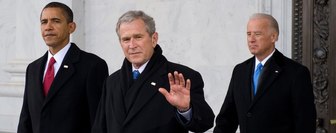Republican challenger Mitt Romney gets a majority of the votes of likely voters over Democratic President Barack Obama in Indiana, 53% Romney to 41% Obama, in a YouGov poll of 495 likely voters statewide (recontacted from an initial September poll).
| In Indiana (Oct 4-11): |
|---|
Indiana’s likely voters are not the country’s strongest partisans, with only 83% of Democrats sticking with Obama, and 88% of Republicans voting for Romney. |
Romney has a strong lead among likely voters who are Independents, 51% Romney-39% Obama. |
Women in Indiana are split, 50% Romney-48% Obama, while men favor the challenger, 57%-35%. |
Romney leads in the Indianapolis suburbs by 67%-29% and in the south by 58%-40%. Obama leads in Marion County (Indianapolis) by 61%-39%. Romney has the edge in the northwest, 51% Romney-44% Obama, and central Indiana outside the Indianapolis area, 52%-38%. |
The oldest likely voters age 65+ favor Romney over Obama (59% Romney-32% Obama), and Romney also leads among Indiana’s Baby Boomers, 58%-37%. Obama leads narrowly (51% Obama-46% Romney) among those age 30-44, and also leads among the youngest likely voters under age 30. |
Romney has only widened what was already a solid standing among Indiana likely voters who are Independents, rising from a 50%-41% lead in September with this key swing group to an even stronger 51%-39% lead among these same Independent likely voters today. |
| Net Change in Voter Intention (Likely Voters) |
|---|
| Total | Independents | |||
|---|---|---|---|---|
Sept 7-14 | Oct 4-11 | Sept 7-14 | Oct 4-11 | |
Barack Obama | 45% | 41% | 41% | 39% |
Mitt Romney | 50% | 53% | 50% | 51% |
Republican Richard Mourdock continue to hold a narrow lead over Democrat Joe Donnelly, 45%-41%, in the race to succeed Sen. Richard Lugar, whom Mourdock upset in the Republican primary. In the Governor’s race to succeed Republican Mitch Daniels, who is term-limited, Republican Mike Pence continues to hold a healthy lead, 49%-38%, over Democrat John Gregg.
In the race for U.S. Representative for their Congressional districts, 47% intend to vote for the Republican candidate for the House in their district, and 36% for the Democrat. The poll was conducted October 4-11.
Sampling method: Respondents were initially selected on September 7-14 from YouGov’s panel using sample matching. A random sample (stratified by age, gender, race, education, and region) was selected from the 2005–2007 American Community Study. Voter registration, turnout, religion, news interest, minor party identification, and non-placement on an ideology scale, were imputed from the 2008 Current Population Survey Registration and Voting supplement and the Pew Religion in American Life Survey. Matching respondents were selected from the YouGov panel, an opt-in Internet panel.
Respondents were recontacted on October 4-11 for the second wave of the YouGov poll. The percentage of likely voters who were successfully recontacted was 75.7%.
Weighting: The sample was weighted using propensity scores based on age, gender, race, education, news interest, voter registration, and non-placement on an ideology scale.
Number of respondents: 495 likely voters.
Margin of error ±5.6% (adjusted for weighting).
Click here for September 7-14 results (registered voters).
Click here for October 4-11 results (likely voters).








